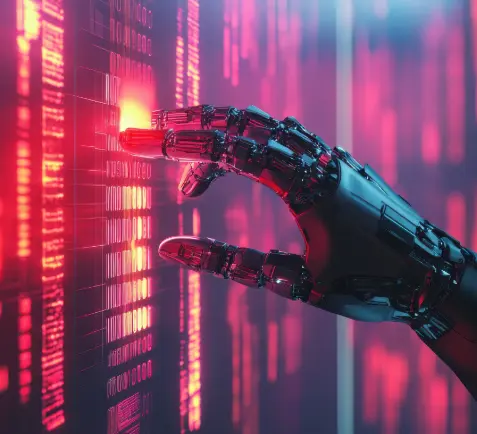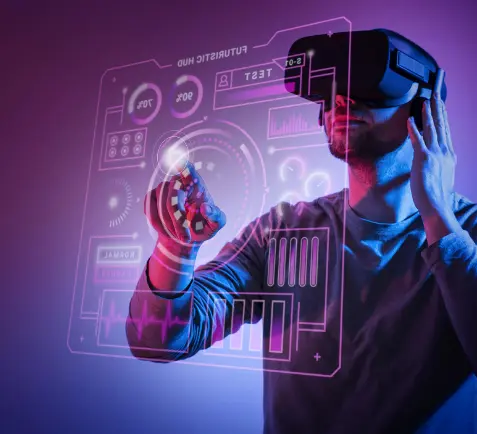Deloitte study shows, that only 34% of consumers believe they get the information they need in virtual settings, and 56% believe they don’t get the same level of service. This created an opportunity for healthcare providers to rethink and improvise their practices to better connect with patients on their preferred channel and provide them with information and more personalized care.
Patients’ perceptions of healthcare services have shifted recently, prompting healthcare professionals to adapt to the latest technologies in order to improve the current healthcare infrastructure. Utilizing Metaverse’s virtual environment, AI, IoT devices, and collaborating with the government’s own NDHM are the latest trends in healthcare.
Let’s take a closer look at how these trends are being used to improve the entire consumer experience.
Artificial Intelligence
Artificial intelligence (AI) is one of the major trends driving healthcare’s digital transformation. Diagnostics, academics, therapy courses, and other fields of healthcare have already implemented it. However, continuous R&D is being done to explore more possibilities for implementing AI technologies in Healthcare.
Currently, AI has proved to be very useful in diagnosing and treating diabetic retinopathy which is a major cause of blindness in India due to the huge diabetic population. For example, Netra.AI, an AI platform, can identify a healthy retina from an unhealthy one with the help of AI algorithms making use of specialized low-powered microscopes with cameras attached to them. Quickly generated reports on this platform enable optometrists to provide instant counsel to patients needing a referral to the hospital.
Computer Vision technology integrated within Conversational AI bots and virtual assistants helps medical professionals to diagnose certain diseases via remote counseling. Many experts are researching how to make the most out of Computer Vision in the field of cancer detection, surgery, and dermatology.
Read more about how Computer Vision is transforming healthcare.
NDHM
The National Digital Health Mission with the help of the United Health Records system aims to address the lack of coordination between healthcare providers, payers, and patients. UHR brings together the electronic medical records of a patient and, most importantly, data from a cohort of different online and offline touchpoints frequented by patients. Furthermore, each person will be given a unique health ID that may be linked to the health IDs of their entire family to provide a complete picture of their medical history.
NDHM will help patients and healthcare professionals by improving longitudinal health record management and making it easier to store and share health records. Patients will be able to browse nearby healthcare providers while on the road. The NDHM framework’s features will go a long way toward ensuring that the Indian healthcare industry has a consistent experience.
Metaverse
Virtual Reality, Augmented Reality, Mixed Reality, AI, and digital currencies are all part of the Metaverse. It’s a web-based collection of interconnected locations. The metaverse is the result of the convergence of three major technological trends: telepresence (which allows people to be together virtually even if they are physically separated), digital twinning, and blockchain (which allows us to create a distributed internet), all of which have the potential to impact healthcare. Together, they have the ability to open up new channels for delivering treatment, lowering costs, and significantly improving patient outcomes.
Apollo Hospitals Group has partnered with 8chili Inc, a deep-tech start-up based in California, to enable patient involvement in the metaverse. Virtual reality (VR) will be used to provide pre/post-operative patient counseling, increasing patient involvement and offering skill mastery for hands-on training for healthcare staff.
IoT and Wearables
In the recent couple of years, wearable technology has become increasingly popular amongst urban populations for health and wellness tracking. Patient monitoring for chronic illness as well as post-op care has become easier for healthcare professionals through IoT devices and wearables. Some IoT solutions use artificial intelligence (AI) to offer clinicians early warnings based on a patient’s vital signs. Many healthcare startups such as Health Care At Home India Pvt Ltd (HCAH) are working towards setting up home ICU units and other treatment infrastructure that can monitor patients’ vital parameters thus enabling a proactive approach to treatment review and modification.
To keep track of patients recovering from high-risk treatments, Manipal Hospitals began using a remote monitoring service linked to Google’s Fitbit devices. These gadgets collect data from patients such as heart rate, oxygen saturation, sleep quality, steps, and pain score, which is then shared with nurses and doctors via an online monitoring service.
According to MarketsandMarkets, the market for wearable medical devices was estimated at $16.2 billion in 2021, with a CAGR of 13.2 percent expected to reach $30.1 billion by 2026. The rise of lifestyle-related illnesses (such as hypertension), the growing need for home healthcare, and the desire to improve patient outcomes are all factors driving this market expansion.
Conclusion: Future of Healthcare Technology
With collaborative care models, data privacy becomes a major concern, and the danger of data loss can have serious ramifications for both the patient and the healthcare organization.
Privacy of data can be ensured through a few specific security measures such as encryption of data and algorithms that enable access by authorized personnel only, regular monitoring of data and information to detect any data compromises, and training healthcare professionals about their data usage, access restrictions, and data security requirements.
Ultimately, customer experience (CX) has risen to the top of the healthcare agenda because it affects every step of the patient’s journey, from interactions with doctors, nurses, and other care providers to insurance companies, pharmacies, hospitals, labs, and other healthcare businesses. R&D in every aspect of the above trends is happening at a rapid pace. Soon, a day will come when a doctor sitting in his clinic miles away from a rural village monitors a patient’s health and provides him with counsel and treatment.
Knowledge thats worth delivered in your inbox




